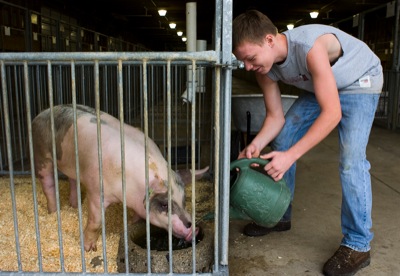Thursday, August 9th, 2012
Board to hire nutrient management technician
District to lobby for state money to fund positions long term
By Nancy Allen
Mercer County Soil and Water Conservation District board members agreed to fill an open nutrient management technician position after the state OK'd funding.
The board on Wednesday also decided to start lobbying politicians and other decision makers for funds to keep two technicians on staff long term.
The posts were created to help livestock farmers in the Grand Lake Watershed complete nutrient management plans (NMPs) by Dec. 15. This is one of the new rules the state mandated when it designated the watershed distressed after humans and animalsbecame ill from algae toxins in Grand Lake in 2010. The algae is fed by phosphorous, which runs off the mostly farmland in the lake's watershed.
"If (the watershed) remains distressed, we're looking at on-farm inspections and visits and revisions of NMPs for every farmer in the watershed every three years," SWCD administrator Nikki Hawk said. "We definitely have the work load to keep them busy."
About 158 farm operators represent 270 livestock farms in the lake watershed.
The state originally allocated $160,000 from the Ohio Department of Natural Resources to fund two technician positions for one year. The funds also pay for their health insurance, public employee retirement system contributions, a vehicle, computers and other office supplies.
The first two nutrient management technicians started in January 2011. Three have quit, with one taking a different job at the SWCD office. The office is now down to one nutrient management technician.
Board member Bro. Nick Renner said the fact that the positions are temporary have made it difficult to keep them filled.
The district has been able to stretch the funds longer than the original year because the SWCD used less than was allocated for equipment, supplies and insurance, Hawk said.
The state recently announced it would allocate an additional $80,000, which would keep two nutrient management technicians on staff another 10 to 12 months.
Hawk said the SWCD will lobby for the more funds using the argument that what is learned through the process will help statewide.
"We want to use these funds to help develop a model that can be used across Ohio and other places to address severe water quality concerns," she said.
SWCD technician Matt Heckler said he is concerned that if the state discontinues funding, other staff will have to forgo their regular work to make sure duties associated with updating NMPs and on-site visits get done.
"By the time you start doing on-site visits, going over records and updating NMPs, it's only going to get worse the closer you get to Dec. 15," Heckler said. "Then NMPs are going to need updated in three years and new soil tests taken ... it just keeps going and going."
Hawk agreed, adding that the nutrient management technicians work won't end after Dec. 15.
"I think we need to put everything into lobbying for this, or everything we've done for the last two years isn't going to be worth it," she said.
So far, 113 of the total 158 NMPs that need to be completed by watershed farmers are done and 45 are in progress, she said. Previously the plans were only mandated for large state-permitted livestock farms in the lake watershed, of which there are 14.
Under other matters, state agricultural engineer Terry Mescher reported the state hopes to have a new state resource specialist hired in September to help farmers comply with the new manure rules. John Kaiser, who previously had held the post, resigned to take another state job. His last day was June 15.
The technicians, Mescher and Kaiser, are among a team of more than 20 local, state and federal employees formed three years ago to help farmers do their part to help restore Grand Lake.
The SWCD board on Wednesday also,
• reviewed two invalid complaints of manure in creeks reported July 26 and Aug. 6, the first in Little Beaver Creek and the second in Beaver Creek. Both turned out to be likely natural occurrences of decaying leaf and vegetation that discolored creeks.
• set the next board meeting for 8 a.m. Sept.12.


